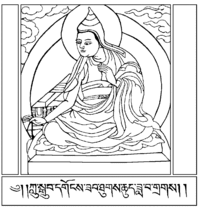Madhyamaka
From Buddha World
Madhyamaka (Sanskrit: मध्यमक, Madhyamaka; also known as Śunyavada) is a Buddhist Mahayāna tradition systematized by Nagarjuna. Nagarjuna may have arrived at his positions from a desire to achieve a consistent exegesis of the Buddha's doctrine as recorded in the Nikayas. In the eyes of Nagarjuna the Buddha was not merely a forerunner, but the very founder of the Madhyamaka system. The tradition and its subsidiaries are called "Madhyamaka;" those who follow it are called "Mādhyamikas." According to the Mādhyamikas, all phenomena are empty of "self nature" or "essence" (Sanskrit: Svabhāva), meaning that they have no intrinsic, independent reality apart from the causes and conditions from which they arise. Madhyamaka is the rejection of two extreme philosophies, and therefore represents the "middle way" between eternalism—the view that something is eternal and unchanging—and nihilism. Nihilism here means the assertion that all things are intrinsically already destroyed or rendered nonexistent. This is nihilism in the sense of Indian philosophy, and may differ somewhat from Western philosophical nihilism.
Prajnaparamita
Madhyamaka is a source of methods for approaching prajnaparamita, or "perfection of wisdom", the sixth of the Six Perfections of the bodhisattva path. The term is used as the collective title of key Mahayana sutras. This is also often explained as the teaching on shunyata that occurred at Vulture Peak, Raj Gir, and has been categorized as the Second Turning of the Wheel of Dharma.
Modern adherents
Not all Mahayana Schools necessarily adhere to the Madhyamaka view or approach, but Tibetan Buddhist traditions adhere to a form of Madhyamaka as well as the Zen traditions, though they have differences in method. The present day schools of Tendai, Sanron and the Maha-Madhyamaka are also heirs to the Madhyamaka tradition.
Tibetan categories
There is currently no historical evidence that the Madhyamikas divided themselves into distinct schools, but later Tibetan scholars—in particular Tibetan translator Patsap Nyima Drak in the 11th century—categorized views into distinct "schools". According to the Tibetan view, subdivisions of Madhyamaka are:
- Prāsaṅgika
- Svātantrika
- The later Yogācāra and Madhyamaka synthesis, sometimes rendered Yogācāra-Svatantrika-Madhyamaka
It is important to note that while these different tenet systems were discussed, it is debated to what degree individual writers in Indian and Tibetan discussion held each of these views and if they held a view generally or only in particular instances.
Prasangika
The only technique avowed by Prāsaṅgika Madhyamaka is to show by prasaṅga (or reductio ad absurdum) that any positive assertion (such as "asti" or "nāsti", "it is", or "it is not") or view regarding phenomena must be regarded as merely conventional (saṃvṛti or lokavyavahāra). No position therefore constitutes the ultimate truth (paramārtha), including the views and statements made by the Prāsaṅgikas themselves, which are held to be solely for the purpose of defeating all views. The Prāsaṅgikas also identify this to be the message of the Buddha who, as Nāgārjuna put it, taught the Dharma for the purpose of refuting all views. Buddhapalita and Candrakirti are noted as the main proponent of this approach. Tibetan teacher Longchen Rabjam noted in the 14th century that Candrakirti favored the prasaṅga approach specifically when discussing the analysis for ultimacy, but otherwise he made positive assertions. His central text, Madhyamakavatara, is structured as a description of the paths and results of practice, which is made up of positive assertions. Therefore, even those most attributed to the Prāsaṅgika view make positive assertions when discussing a path of practice but use prasaṅga specifically when analyzing for ultimate truth.
Svātantrika
The Svātantrika Madhyamaka differs from the Prāsaṅgika in a few key ways. Conventional phenomena are understood to exist conventionally without existing ultimately. In this way they can make positive or "autonomous" assertions using syllogistic logic, and their name comes from this quality of autonomous statements. Svatantrika in Sanskrit refers to autonomy and was translated back into Sanskrit from the equivalent Tibetan term. They also draw a distinction between the final ultimate truth and approximate or enumerative ultimates that describe the ultimate but are not the true ultimate. Bhavaviveka is the first person to whom this view is attributed, as they are laid out in his commentaries on Nagarjuna and his critiques of Buddhapalita. Ju Mipham explained that using positive assertions in logical debate may serve a useful purpose, either while debating with non-Buddhist schools or to move a student from a coarser to a more subtle view. Similarly, discussing an approximate ultimate helps students who have difficulty using only prasaṅga methods move closer to the understanding of the true ultimate. Ju Mipham felt that the ultimate non-enumerated truth of the Svatantrika was no different from the ultimate truth of the Prāsaṅgika. He felt the only difference between them was with respect to how they discussed conventional truth and their approach to presenting a path. Gelug teachers, however, have instead criticized the Svatantrika approach as not delivering students to the same point as the Prāsaṅgika approach.
Yogācāra-Svatantrika-Madhyamaka
A Yogacara and Madhyamaka synthesis was posited by Shantarakshita in the 8th century and may have been common at Nalanda University at that time. Like the Prāsaṅgika, this view approaches ultimate truth through the prasaṅga method, yet when speaking of conventional reality they may make autonomous statements like the earlier Svātantrika and Yogācāra approaches. This was different from the earlier Svatantrika in that the conventional truth was described in terms of the theory of consciousness-only instead of the tenets of Svatantrika, though neither was used to analyze for ultimate truth. For example, they may assert that all phenomena are nothing but the 'play of mind' and hence empty of concrete existence—and that mind is in turn empty of defining characteristics. But in doing so, they're careful to point out that any such example would be an approximate ultimate and not the true ultimate. By making such autonomous statements, Yogācāra-Svatantrika-Madhyamaka is often mistaken as a Svātantrika or Yogācāra view, even though a Prāsaṅgika approach was used in analysis. This view is thus a synthesis of Madhyamaka and Yogācāra.
Interdependence
The Madhyamaka concept of emptiness is often explained through the related concept of interdependence. This is in contrast to independence, that phenomena arise of their own accord, independent of causes and conditions. Although a common way to think about emptiness, it is a conceptual way of talking about it—to lead a student closer to the non-conceptual wisdom of the ultimate truth—and it would not withstand analysis as an ultimate view. In the first chapter of the Mulmadhyamakakarika, Nagarjuna provides arguments that even causes and conditions are empty of inherent existence or essence. This analogy, however, connects the conclusion of the Middle Way tenets with the codependent origination teachings of the first turning. The analogy to interdependence is considered helpful for students, and is presented in the famous ninth chapter of Shantideva's Bodhicharyavatara, as well as by modern writers like Thich Nhat Hanh who, in The Heart of Understanding, discusses the Heart Sutra in terms of interdependence. In this analogy, there is no first or ultimate cause for anything that occurs. Instead, all things are dependent on innumerable causes and conditions that are themselves dependent on innumerable causes and conditions. The interdependence of all phenomena, including the self, is a helpful way to undermine mistaken views about inherence, or that one's self is inherently existent. It is also a helpful way to discuss Mahayana teachings on motivation, compassion, and ethics. The comparison to interdependence has produced recent discussion comparing Mahayana ethics to environmental ethics.

 Русский
Русский
